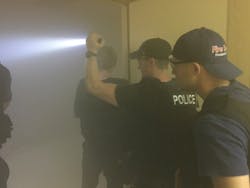MD Medics Hone Tactical Medical Skills
FREDERICK, MD -- It was a unique environment for a select team of Frederick County medics. But, they adapted quickly.
They donned tactical gear, switched ball caps for helmets and left the cardiac monitors and drug boxes behind.
The new tactical EMS team trained with the Frederick Police SWAT officers last week following an intense four-day course taught by National Tactical Officers Association (NTOA) instructors.
More special response teams throughout the country are including medics, who can begin life-saving treatment to both officers and civilians, explained Mark Gibbons, who coordinated to NTOA training.
Gibbons, a retired Maryland State Police major, was one of the first medics on the state team. Now, he shares his knowledge and experience with crews across the country.
Medics learn early on that tactical decisions are not based on medical emergencies. That’s why they have to adapt fast in dangerous, ever-changing environments.
Kits carried by the tactical EMS teams contain chest patches, tourniquets and other bleeding control supplies as well as airways, hand-held suctions, and masks.
“Once the blood is on the ground, you can’t put it back in,” Gibbons said, adding that it’s essential that severe bleeding be controlled immediately.
Gibbons said medics are making the difference. “Teams are going into very dangerous environments. These people are providing life sustaining care before an ambulance crew or a helicopter arrives…”
At the Pulse nightclub in Orlando, medical care to victims was delayed for hours because medics had to wait until SWAT swept the area.
Frederick SWAT Leader Sgt. Paul Beliveau said he is pleased the medics are being integrated.
“The chief is very supportive as is the mayor. Things started coming into alignment, and I’m confident it’s going to work well…”
On the last day of training, the team was faced with various scenarios. One included entering a smoke-filled building where they found numerous ‘victims’ after an explosion.
They cautiously made their way through the rooms, and called out to people crying for help.
The medics would later agree the training was intense, and pushed them to react under pressure.
Battalion Chief Mike Cole explained the medic/firefighters interested submitted resumes and had to be recommended by the medical director, station officer and EMS supervisor.
“They had to pass the same agility test as the city officers,” Cole said, adding that the candidates also were interviewed.
Cole, who helped develop the program, said city police have been very supportive and accommodating. “They’ve been very welcoming. We all want this to work…”
Both the local and state medical directors reviewed the protocols, and approved the program.
The four-day course that included presentations from the FBI, ATF and other agencies didn’t cost anything.
“This is our way of giving back to our community. We live in this county, and having people well-trained is important,” Gibbons said.
Likewise, MSP Sgt. Kevin Straight, also a county resident, said he was pleased to volunteer his time to help train the medics.
“It’s been a rewarding experience for all of us. We all typically do different things. This is where it all comes together…” Straight said, adding that having the medics entering with the team adds another level of protection.
Gibbons added a number of other instructors also came on board when they heard about the gratis class. “It was amazing so many people stepped up.”
Medic Jonas Zeigler said of his experience: “It was very challenging, very dynamic. I loved it…”
As they continue to train with the city officers, now that they have the national certification course, they will hone skills and get a better understanding of how things work.
Likewise, Medic Kenneth Smith said it was the best training he’d ever been through. “There were new theories to work through with the goal of keeping everyone safe...”
Cpl. Reed Preece, assistant SWAT team leader, said he thought the medics and officers worked well together. “I think the integration is a good idea…”
Medic Bernie Studds explained: “This was different than anything I’ve ever done. It was a different mindset and definitely, a different environment…”
Gibbons said he was impressed with the caliber of medics selected.
“It was interesting to see how well they worked as a team, and adapted to the situations…”
